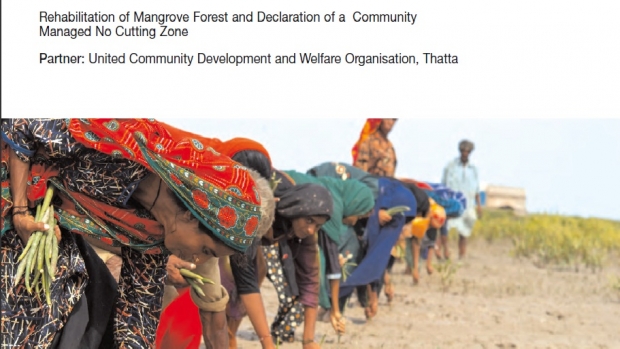Grants :: Small Grant Facilities :: Manning the Mangroves
Manning the Mangroves

Manning the Mangroves, Sindh, Pakistan
Objectives
To conserve the mangrove forests in the vicinity of Kharioon coastal village in the Keti-Bunder area through community based management and sustainable utilization.
Background
The project is focused on community-based management of natural resources in the vicinity of Kharioon coastal village in Keti Bunder. The most significant natural resource of the project area is fish, which forms an integral basis for the livelihoods for local communities residing in creeks and inland villages. The mangroves are also a source of fuel wood and fodder for animals. Protecting the existing plantations is a challenge due to open camel grazing in the project area, which has even given rise to conflicts with the camel owners. Under the project, an attempt has been made to engage the camel owners by protecting the newly established mangrove plantation through regular meetings and dialogue with them. The project has also attempted to identify and designate an area of mangrove forest as protected and ‘no cutting zone’. Through a mobilization process, certain rules were agreed upon amongst the stakeholders that prevent grazing and harvesting of wood from the area. Further, these rules prohibited fishing in the declared zone during the project period in order to allow for the recovery of the mangrove vegetation and for the breeding of crabs, shrimps and fish. Plans are in place to curtail harvesting even after the project has ended.
Target beneficiaries
The project beneficiaries include local fishing communities and camel owners.
Outputs
1. Encourage participatory mechanism for establishment of a protected zone.
2. Mangrove rehabilitation on 100 hectares through mobilization of local communities and camel owners and by engaging the forest officials.
3. Sensitize local communities towards sustainable natural resource management (including use) and fishing practices.
Accomplishments and challenges
1. Project area boundary was marked through GIS application.
2. Establishment of a check post in the project area.
3. Establishment of mangroves nursery consisting of 4000 saplings.
4. More than 50000 propagules of the Rhizophora mucronata species were collected and planted in 100 ha area along with Ceriops tagal and Avicennia marina species.
5. Environmental events were celebrated at the community level to raise awareness and to foster engagement for sustainable management.
Challenges
The project implementing CBO is still young and faced initial constraints in developing the technical and financial reports. This was a challenge, which the CBO has overcome and learnt from.
The high tides and rough sea conditions were a major problem during mangrove plantations and for both the establishment as well as durability of signposts to mark the protected zone.
A failure in growth of the Ceriops tagal species was observed.
Dealing with Government Departments is a challenge yet is also essential, as Government endorsement leads to more sustainable outcomes.
Contributions to cross-cutting themes
Communications
Knowledge products like brochures and pamphlets were developed including a video on the importance of mangroves.
Gender equality
Women in the project area were involved in mangrove planting and protection and were part of environmental awareness raising programmes.
Climate change
The project has established a ‘no cutting zone’ that will help the mangroves to flourish, therefore, improve protection against disasters, and will contribute to fisheries and associated livelihoods potential, both of which entail efforts for adaptation towards climate change impacts.
Lessons Learned
Plantation of mangroves is seasonal and somewhat technical. The failure of Ceriops tagal species indicates that the conditions were not favourable for their growth, as compared to Rhizophora and Avicennia, which are the recommended species for the area.
Project Facts
Country
Location
Kharioon coastal village, Keti Bunder, Sindh, Pakistan
Topic
Duration
1st Nov 2011 to 30th Jun 2012
MFF Grant Amount
PKR 750,000
Implementing Partner
United Community Development and Welfare Organisation,
Shakeel Memon
Post office Keti Bunder Town,
District Thatta
ketibunder@gmail.com
Tel: + 92 312 3440996